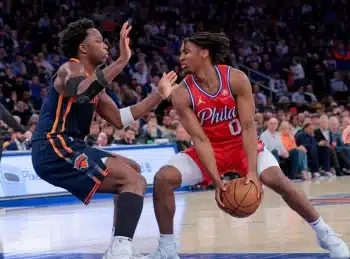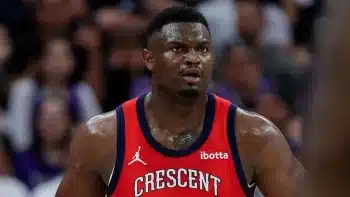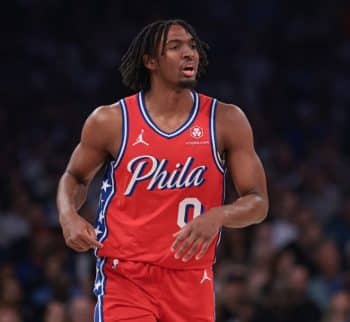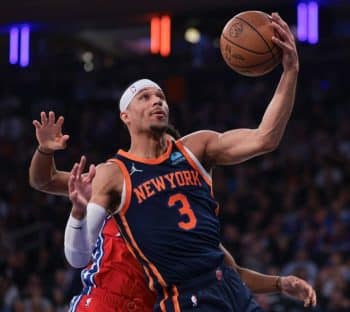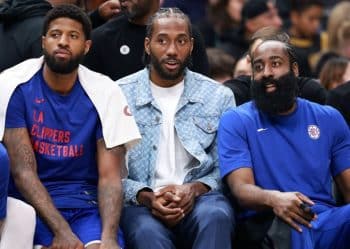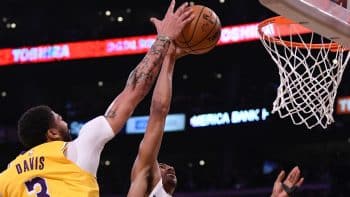NBA
2017 NBA Collective Bargaining Agreement – Deal Points

2017 NBA COLLECTIVE BARGAINING AGREEMENT – PRINCIPAL DEAL POINTS
The following is a summary of the principal changes made to the NBA/NBPA Collective Bargaining Agreement, per the NBA. With limited exceptions, new CBA terms take effect on July 1, 2017.
I. Term of Agreement
The new collective bargaining agreement will have a seven-year term covering the 2017-18 through 2023-24 seasons. Both the NBA and NBPA have the ability to opt out of the CBA after the 2022-23 season by providing notice to the other party by December 15, 2022.
II. Key Unchanged Elements from the 2011 CBA
• The players’ share of Basketball Related Income (BRI) will remain in the 49%-51% band.
• The Salary Cap and Tax structure will remain the same, including the calculation of Cap/Tax Levels, use of Salary Cap Exceptions, Tax rates and transaction limits on teams over the Tax “Apron.”
• The escrow system will remain the same.
• Existing rules on maximum free agent contract length will be retained.
• Restricted free agency will remain in place with certain process-related changes.
III. System
A. “Right-Sizing”
Certain System elements will be adjusted upward to maintain their relative position in the overall player compensation system, as set forth below:
• Exception Amounts. The Mid-Level Exceptions and Bi-Annual Exception for 2017-18 will be increased 45% from the amounts in the 2011 CBA. The revised amounts will increase or decrease annually beginning in 2018-19 at the same rate as the Salary Cap.
• Rookie Scale/Existing Rookie Scale Contracts. The Rookie Scale will also be increased 45%, with the increase phased in over three years. The Rookie Scale will increase or decrease annually beginning in 2018-19 at the same rate as the Salary Cap. As under the 2011 CBA, there will be a new Rookie Scale each season. Going forward, the Rookie Scale for a season will be issued prior to the start of the Moratorium Period for that season to reflect the increase or decrease in the Salary Cap from the prior season. Existing Rookie Scale contracts will be amended to reflect the 45% increase (phased in over the three-year period). The salary increases for existing Rookie Scale contracts will be funded collectively through a league-wide fund.
• Minimum Annual Salary Scale. As with the Rookie Scale, there will be a new Minimum Annual Salary Scale issued each season prior to the Moratorium Period for contracts, including multi-year contracts, signed that season. The 2017-18 Minimum Annual Salary Scale will increase minimum salaries for that season by 45%. The revised amounts will increase or decrease annually beginning in 2018-19 at the same rate as the Salary Cap.
• High-End Spending. In 2017-18, the Tax “Apron” – the amount above the Tax Level that cannot be exceeded by any team that uses the Non-Taxpayer Mid- Level Exception or Bi-annual Exception or acquires a free agent in a sign-and- trade – will be increased from $4M greater than the Tax Level to $6M greater than the Tax Level, and this $6M amount will increase or decrease annually beginning in 2018-19 at one-half the rate of the increase or decrease in the Salary Cap.
• Maximum Annual Cash Limit in Trades. The 2017-18 limit on cash paid or received in trades will be increased from $3.6M to $5.1M, and this amount will increase or decrease annually beginning in 2018-19 at the same rate as the Salary Cap.
• Annual Increases. The maximum annual salary increase/decrease for “Bird” players (7.5%) and other players (4.5%) will be increased to 8% and 5%, respectively.
B. Extension/Player Retention Rules
1. Veteran Extensions
• Increased Extension Length. Veteran extensions (other than Designated Veteran Player Extensions as described below) will be permitted to cover five total years as follows: four new years if one year remains on the current contract, or three new years if two years remain on the current contract. (Under the 2011 CBA, veteran extensions may cover four total years.)
• Waiting Period to Extend. A player whose contract (other than a Rookie Scale Contract) is a three- or four-year contract will be permitted to enter into a Veteran Extension no sooner than the second anniversary of the signing of the contract. (Under the 2011 CBA, a contract covering a term of three or fewer years may not be extended, and a four-year contract may not be extended until the third anniversary of the signing of the contract.) The waiting period for extending a 5-year contract will remain unchanged (third anniversary of the signing of the contract).
• First-Year Salary. The maximum allowable salary in the first year of a Veteran Extension (other than a Designated Veteran Player Extension as described below) will be increased from 107.5% of the player’s salary in the last year of the original term of the contract to 120% of the greater of: (i) the player’s salary in the last year of the original term of the contract; or (ii) the estimated average player salary for the year in which the extension is signed.
• Timing of Veteran Extensions. If a player and a team seek to enter into any Veteran Extension (other than a Designated Veteran Player Extension as described below) more than one year prior to the July 1 preceding the proposed first season of the extended term, then the extension may only be negotiated and signed during the off-season (i.e., from July 1 through the day prior to the first day of the regular season).
2. Designated Veteran Player Extensions
a. Eligibility and Contract Length
• Years of Service and Performance Criteria. Players with one year or two years left on their contracts who have seven or eight years of service in the league and have never changed teams (other than, if applicable, by being traded during their first four seasons in the league), and who meet certain performance criteria (defined in section B.2.c below), will be eligible to negotiate a veteran extension covering six total years (five new years if one year remains on the current contract or four new years if two years remain on the current contract).
• Waiting Period. Designated Veteran Player Extensions can be signed no sooner than the third anniversary of the signing of the contract.
• Off-Season Signing Period. Designated Veteran Player Extensions can only be negotiated and signed during the off-season (i.e., from July 1 through the day prior to the first day of the regular season).
• Maximum Allowable Number. A team cannot sign a player to a Designated Veteran Player Extension if at any point in time in a current or future year the team has or will have included in its Team Salary more than two contracts (i) extended pursuant to this section, and/or (ii) signed pursuant to section B.4 below.
b. Salary
Designated Veteran Player Extensions will be required to provide for a first- year salary of at least 30% and no more than 35% of the Salary Cap (under the 2011 CBA, such players’ applicable maximum first-year salary is 30% of the Salary Cap).
c. Performance-Based Criteria
For purposes of qualifying to negotiate for the Designated Veteran Player Extension described above or the maximum salary for certain free agents described in section B.4 below, a player will have to meet at least one of the following performance criteria at the time of signing:
• the player was named to the All-NBA first, second, or third team, or was named Defensive Player of the Year, in the immediately preceding season or in two of the immediately preceding three seasons; or
• the player was NBA MVP during one of the preceding three seasons.
Any player who is extended pursuant to these criteria (or signed as a free agent pursuant to section B.4 below) cannot be traded for one year from the date of signing.
For any player who previously met the Designated Veteran Player performance criteria, has not yet reached unrestricted free agency, and, but for signing a Veteran Extension in 2016-17 prior to the execution of the new CBA, could or would have been eligible to sign a Designated Veteran Player Extension or a free agent contract as a Designated Veteran Player during the term of the new CBA (beginning in 2017-18), the following rule will apply: such a player will be permitted, in the off-season after his 8th or 9th season (as applicable), to negotiate a Designated Veteran Player Extension, provided that the player meets the applicable eligibility rules (but for the extension in 2016-17) and performance criteria at the time the Designated Veteran Player Extension is signed.
3. Rookie Scale Extensions
a. Maximum Annual Salaries in Rookie Scale Extensions
The rule allowing a team and a player who meets certain performance criteria to negotiate a maximum salary of up to 30% of the Salary Cap in Rookie Scale Extensions (or certain free agent contracts) will remain in effect, but the performance criteria will be changed so as to be the same as the performance-based criteria described in section B.2.c above. In addition, for Rookie Scale Extensions where, at the time the extension is signed, the player has not already met the performance-based criteria, a team and player can agree upon various percentages of the Salary Cap (between 25% and 30%) based upon how and whether the player satisfies the criteria. For example, a team and player can agree that the player’s salary in the first season of the extended term will be 30% if the player wins the MVP award, or 27.5% if the player is named to the All-NBA first or second team in his fourth season.
b. Designated Rookie Scale Player Extensions
The number of Designated Rookie Scale Player Extensions that a team can sign (and have included in its Team Salary at any point in time) will increase from one to two. A team will continue to be limited at any point in time to a total of two Designated Rookie Scale Player Extensions (one of which could be acquired by trade).
c. Rookie Scale Extension Deadline
The deadline for entering into Rookie Scale Extensions will be changed from 11:59 p.m. (ET) on October 31 to 6:00 p.m. (ET) on the day prior to the first day of the regular season.
4. Designated Veteran Player Free Agents
Free agents who have eight or nine years of service in the league who have never changed teams (other than, if applicable, being traded during their first four seasons in the league) and who meet certain performance-based criteria (defined in section B.2.c above) will be able to sign with their own team for a first- year salary of up to 35% of the Salary Cap (under the 2011 CBA, such players’ applicable maximum first-year salary is 30% of the Salary Cap). Under this provision, any contract that provides for a player’s salary to be more than 30% of the Salary Cap will be required to be a five-year contract. A team will not be permitted to sign a player to a Designated Veteran Player free agent contract if at any point in time the team has or will have included in its Team Salary more than two contracts (i) signed pursuant to this section, and/or (ii) extended pursuant to section B.2 above.
C. Moratorium Period
The Moratorium Period has been shortened and will now end each season at noon (ET) on July 6. The Salary Cap and Tax Level will be set each season by June 30.
D. Restricted Free Agency
The following changes will be made to restricted free agency:
• Match Period. The period for a team with a right of first refusal to match an Offer Sheet will be shortened from 3 days to 2 days.
• Offer Sheets During the Moratorium Period. A player will be able to sign an Offer Sheet during the Moratorium Period. A team holding a right of first refusal will have from the conclusion of the Moratorium Period until 11:59 p.m. (ET) on July 8 to match such an Offer Sheet.
• Qualifying Offer Withdrawal Deadline. The July 23 deadline for a team to unilaterally withdraw a Qualifying Offer will be changed to July 13.
E. Other Changes
1. Additional Trade Rules
• Traded Player Exception. The 150% Traded Player Exception for non- taxpaying teams will be increased to 175% (still subject to a limit of the salaries of the players being traded plus $5M).
• Trade Exceptions/Protected Salary. For contracts entered into or extended beginning with the 2017-18 season: (i) in circumstances where a player’s salary protection is less than full, Traded Player Exceptions arising from the trade of such contracts will be calculated based upon the amount of the player’s protected salary in the applicable season (rather than the sum of the player’s protected salary and unprotected salary); and (ii) with respect to trades conducted following the last day of a regular season, Traded Player Exceptions will be limited to the amount of the player’s protected salary for the following season.
2. Salary Cap Holds
• Rookie Salary Cap Holds. Salary Cap holds for unsigned first round draft picks will be 120% of the player’s applicable Rookie Scale amount (increased from 100% under the 2011 CBA).
• First Round Draft Picks. Beginning with the 2018-19 Salary Cap Year, Salary Cap holds for players finishing the second option year of their Rookie Scale Contract will be 250%/300% of the player’s prior salary if the player’s prior salary is above/below the average player salary (increased from 200%/250% under the 2011 CBA).
3. Maximum Salaries
Maximum annual salaries will be calculated using the actual Salary Cap. (Under the 2011 CBA, a separate (lower) salary cap is used to calculate players’ individual maximum annual salaries.)
4. Over-36 Rule
The Over-36 Rule will be modified to be an Over-38 Rule.
5. Stretch
A team that elects to stretch a player’s salary for Salary Cap purposes will be not be allowed to re-sign or re-acquire the player prior to the July 1 following the last season of the player’s contract.
6. Signing Restriction
If a team and player agree on a buyout of the player’s contract to reduce the amount of protected compensation in connection with the team requesting waivers on the player, the team will not subsequently be permitted to sign the player to a new contract (or claim the player off of waivers) before the later of one year following the contract termination or the July 1 following the last season of the player’s contract.
7. NBA Minimum Roster
• 14-Player Rosters. Teams will be required to carry 14 players on their rosters, subject to the ability to carry fewer players for limited periods of time (under the 2011 CBA teams are generally required to carry 13 players).
• Potential 15-Player Rosters. If, beginning in the 2017-18 regular season, the league averages fewer than 14.5 players per team in any two consecutive seasons (not including Two-Way Players), then the above roster requirement would be increased to generally require teams to carry 15 players on their rosters beginning in the following season.
IV. Player Development and Eligibility
A. D-League: Two-Way Contracts
• Two-Way Contracts. Each NBA team will be permitted to have on its roster up to two players under “Two-Way Contracts.” A “Two-Way Player” will provide services primarily to the NBA team’s D-League affiliate, and can be on the NBA team’s Active or Inactive List for up to 45 days during the NBA regular season, as well as on the NBA team’s roster prior to the start of D-League training camp (including during NBA training camp) and after the conclusion of the D-League regular season.
• Exclusive Rights. During the term of a Two-Way Contract, a Two-Way Player will be eligible to sign a standard NBA contract only with his current team.
• Right to “Convert”. A Two-Way Player’s team will have the right to “convert” the Two-Way Contract during its term to a standard NBA contract at the player’s applicable minimum salary and for the same term.
• Transition Rule. Until all NBA teams have a one-to-one affiliation with a D- League team, a process similar to the current “flexible assignment” process will be used to determine the placement in the D-League of Two-Way Players who are signed by NBA teams that do not have a one-to-one affiliation with a D- League team.
B. Career Opportunities for Former Players
A D-League apprenticeship program will be established in the league office and with D-League team coaching staffs to provide business and basketball operations training for former NBA players. In addition, a D-League assistant coach program will be established to provide additional coaching training and experience for former NBA players.
V. Scheduling
A. Training Camp, Pre-Season, and Regular Season Schedule
The period for training camp and the pre-season will be shortened by 7 days, and the maximum number of exhibition games per team prior to any regular season will be reduced to 6 (from 8). The regular season will be played over approximately 177 days (rather than 170 days).
B. Days Off
The number of days off that teams provide players during the Regular Season will increase to 18 (from 16).
V. Player Benefits
The agreement includes significant enhancements to player pension, health, and other benefits. Among other things, beginning this season and for the term of the new CBA, the NBA will equally fund with the Players Association, outside of the players’ share of BRI, the cost of a new health insurance plan and increased pension benefits for eligible currently-retired players who helped pave the way for the game’s current popularity and success.
VI. Anti-Drug Program
A. Testing
Baseline levels of testosterone will be established for each player to increase the accuracy of testing for performance-enhancing substances.
B. Penalties
Penalties will increase for positive tests for performance-enhancing drugs – a 25- game suspension for a first violation (from 20 games) and a 55-game suspension for a second violation (from 45 games). A third positive test will continue to result in the player’s expulsion from the NBA.
VII. Domestic Violence Policy
A comprehensive policy will be put in place that includes, among other things, education, support, treatment, referrals, counseling, and other resources.
VIII. BRI
Changes will be made to the BRI calculation and to the BRI audit process that include, among other things: (i) adjusting certain BRI inclusion and deduction rules; (ii) resolving recurring BRI audit open items; and (iii) clarifying and updating audit procedures.
IX. Group Licensing
The Group License Agreement will terminate following the 2016-17 season. There will be a transition period through September 2017.
